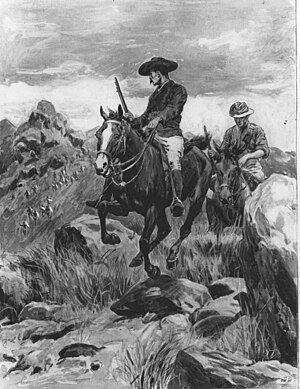Second Matabel War
| date | 1896-1897 |
|---|---|
| place | Rhodesia |
| output | British victory |
The Second Matabele War was a war between the Matabele people and troops of the British Empire and the British South African Society . After the Jameson Raid, which was loss-making for the white settlers, at the turn of the year 1895-1896, the Matabele rose up in the spring of 1896 under their spiritual leader M'limo and the Shona .
M'limo called on his followers to arm themselves and to assemble on three sides around Bulawayo at a certain phase of the moon in order to storm the place at night and kill the inhabitants. The road over the Mangwe Pass should be left open to allow the rest of the whites in the country to escape. Bulawayo itself was not to be destroyed, but to become the royal kraal again for the Matabele king Lobengula , who died in 1894 and who would rise again. After the Battle of Bulawayo, the warriors were to split up into small units in order to kill the whites on the farms in the country. M'limo prophesied that the whites' bullets would be turned into water during their flight and that their shells would turn into eggshells.
The suppression of the uprising
The uprising began prematurely on March 24, 1896. In their lust for battle, some Matabele warriors lost their discipline and began to kill white settlers, women, children and old people in many places on the way to Bulawayo. This alerted the authorities in Bulawayo and gave them enough time to prepare to defend the city. The 7,000 Matabele warriors who had gathered around Bulawayo could be delayed by the defenders. Some of the Matabele were in possession of some captured rifles, Martini-Henry rifles with which the British were equipped as standard, Winchester repeaters and old hunting rifles . Otherwise, the Matabele were armed with assegais , clubs, and battle axes.
The settlers in Bulawayo immediately organized the Bulawayo Field Force - patrols of 40 men each, which were sent into the surrounding area to warn, gather and organize white settlers. At the end of April and the beginning of June 1896, two British relief units reached Bulawayo and smashed the Matabele units, which split up into smaller units and fled into the confusing Matobo Mountains . In June the uprising spread to Mashona lands . The last insurgents in this area could not be defeated until November 1896.
On June 24, 1896, two scouts, Frederick Russell Burnham and Bonnar Armstrong, succeeded in killing M'limo in an ambush in the Matopo Mountains. On August 18, messengers from the remaining Izinduna Sikombo and Inyanda came to the camp and asked for peace negotiations. Three days later they, Cecil Rhodes and 40 other chiefs had a conversation lasting more than four hours . Another meeting, at which the Matabele were moved to lay down their arms and take advantage of the upcoming sowing season, took place on August 28 in the eastern part of the Matopo Mountains. A moderate peace was made with the Matabele, who were not pursued, but allowed the British to settle more settlers in the country.
Only the Shona refused to accept a peace and fought until November 1897, with the British executing the religious leaders of the Shona after the suppression of the uprising because they suspected that they were the ringleaders of the uprising.
Although about 10% of the British settlers perished in the course of the uprising, the uncontrolled land grabbing of British settlers in Matabele and Mashonaland continued and led to the consolidation of British colonial rule in these areas.
See also
literature
- Michael D. Stevenson: Matabele-Mashona Uprising 1896. In: James Stuart Olson , Robert Shadle (eds.): Historical Dictionary of the British Empire. Volume 2: K-Z. Greenwood Press, Westport CT 1996, ISBN 0-313-29367-8 , pp. 729-731.
Individual evidence
- ↑ Entry at country-facts.com ( Memento from December 28, 2015 in the Internet Archive )
- ^ Daniel Robert Kramer: The mercenary being. Military Entrepreneurship in the Genesis of the International System. VS, Verlag für Sozialwissenschaften, Wiesbaden 2010, ISBN 978-3-531-17394-8 , p. 99.
- ↑ Michael D. Stevenson: Matabele-Mashona Uprising 1896. In: James Stuart Olson, Robert Shadle (ed.): Historical Dictionary of the British Empire. Volume 2: K-Z. Greenwood Press, Westport CT 1996, p. 730
- ^ New York Times , June 25, 1896 .
- ↑ Michael D. Stevenson: Matabele-Mashona Uprising 1896. In: James Stuart Olson, Robert Shadle (ed.): Historical Dictionary of the British Empire. Volume 2: K-Z. Greenwood Press, Westport CT 1996, p. 731.
